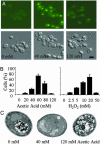Apoptosis induced by environmental stresses and amphotericin B in Candida albicans
- PMID: 14623979
- PMCID: PMC283591
- DOI: 10.1073/pnas.2332326100
Apoptosis induced by environmental stresses and amphotericin B in Candida albicans
Abstract
New antifungal agents are urgently required to combat life-threatening infections caused by opportunistic fungal pathogens like Candida albicans. The manipulation of endogenous fungal programmed cell death responses could provide a basis for future therapies. Here we assess the physiology of death in C. albicans in response to environmental stresses (acetic acid and hydrogen peroxide) and an antifungal agent (amphotericin B). Exposure of C. albicans to 40-60 mM acetic acid, 5-10 mM hydrogen peroxide, or 4-8 microg.ml-1 amphotericin B produced cellular changes reminiscent of mammalian apoptosis. Nonviable cells that excluded propidium iodide displayed the apoptotic marker phosphatidylserine (as shown by annexin-V-FITC labeling), were terminal deoxynucleotidyltransferase-mediated dUTP nick end labeling (TUNEL)-positive (indicating nuclease-mediated double-strand DNA breakage), and produced reactive oxygen species. Ultrastructural changes in apoptotic cells included chromatin condensation and margination, separation of the nuclear envelope, and nuclear fragmentation. C. albicans cells treated at higher doses of these compounds showed cellular changes characteristic of necrosis. Necrotic cells displayed reduced TUNEL staining, a lack of surface phosphatidylserine, limited reactive oxygen species production, and an inability to exclude propidium iodide. Necrotic cells lacked defined nuclei and showed extensive intracellular vacuolization. Apoptosis in C. albicans was associated with an accumulation of cells in the G2/M phase of the cell cycle, and under some apoptosis-inducing conditions, significant proportions of yeast cells switched to hyphal growth before dying. This is a demonstration of apoptosis in a medically important fungal pathogen.
Figures





Similar articles
-
Antifungal drug susceptibility of oral Candida albicans isolates may be associated with apoptotic responses to Amphotericin B.J Oral Pathol Med. 2010 Feb;39(2):182-7. doi: 10.1111/j.1600-0714.2009.00811.x. Epub 2009 Jul 27. J Oral Pathol Med. 2010. PMID: 19656268
-
Ocimum sanctum (L.) essential oil and its lead molecules induce apoptosis in Candida albicans.Res Microbiol. 2014 Jul-Aug;165(6):411-9. doi: 10.1016/j.resmic.2014.05.031. Epub 2014 May 21. Res Microbiol. 2014. PMID: 24858938
-
The antimicrobial peptide, psacotheasin induces reactive oxygen species and triggers apoptosis in Candida albicans.Biochem Biophys Res Commun. 2011 Feb 11;405(2):267-71. doi: 10.1016/j.bbrc.2011.01.026. Epub 2011 Jan 8. Biochem Biophys Res Commun. 2011. PMID: 21219857
-
Reactive oxygen species modulate itraconazole-induced apoptosis via mitochondrial disruption in Candida albicans.Free Radic Res. 2018 Jan;52(1):39-50. doi: 10.1080/10715762.2017.1407412. Epub 2017 Dec 4. Free Radic Res. 2018. PMID: 29157011 Review.
-
Oxidative stress responses in the human fungal pathogen, Candida albicans.Biomolecules. 2015 Feb 25;5(1):142-65. doi: 10.3390/biom5010142. Biomolecules. 2015. PMID: 25723552 Free PMC article. Review.
Cited by
-
S-Adenosyl-L-methionine protects the probiotic yeast, Saccharomyces boulardii, from acid-induced cell death.BMC Microbiol. 2013 Feb 13;13:35. doi: 10.1186/1471-2180-13-35. BMC Microbiol. 2013. PMID: 23402325 Free PMC article.
-
A MAP kinase pathway is implicated in the pseudohyphal induction by hydrogen peroxide in Candica albicans.Mol Cells. 2012 Feb;33(2):183-93. doi: 10.1007/s10059-012-2244-y. Epub 2012 Feb 15. Mol Cells. 2012. PMID: 22358510 Free PMC article.
-
The Role of Signaling via Aqueous Pore Formation in Resistance Responses to Amphotericin B.Antimicrob Agents Chemother. 2016 Aug 22;60(9):5122-9. doi: 10.1128/AAC.00878-16. Print 2016 Sep. Antimicrob Agents Chemother. 2016. PMID: 27381391 Free PMC article. Review.
-
Roles of the pro-apoptotic factors CaNma111 and CaYbh3 in apoptosis and virulence of Candida albicans.Sci Rep. 2022 May 9;12(1):7574. doi: 10.1038/s41598-022-11682-y. Sci Rep. 2022. PMID: 35534671 Free PMC article.
-
Role of actin cytoskeletal dynamics in activation of the cyclic AMP pathway and HWP1 gene expression in Candida albicans.Eukaryot Cell. 2007 Oct;6(10):1824-40. doi: 10.1128/EC.00188-07. Epub 2007 Aug 22. Eukaryot Cell. 2007. PMID: 17715368 Free PMC article.
References
-
- Odds, F. C. (1988) Candida and Candidosis (Baillière Tindall, London), 2nd Ed.
-
- Banerjee, S. N., Emori, T. G., Culver, D. H., Gaynes, R. P., Jarvis, W. R., Horan, T., Edwards, J. R., Tolson, J., Henderson, T. & Martone, W. J. (1991) Am. J. Med. 91, 86S-89S. - PubMed
-
- Pfaller, M. A. (1996) Clin. Infect. Dis. 22, S89-S94. - PubMed
-
- Mah, T. F. & O'Toole, G. A. (2001) Trends Microbiol. 9, 34-39. - PubMed
Publication types
MeSH terms
Substances
LinkOut - more resources
Full Text Sources
Other Literature Sources

